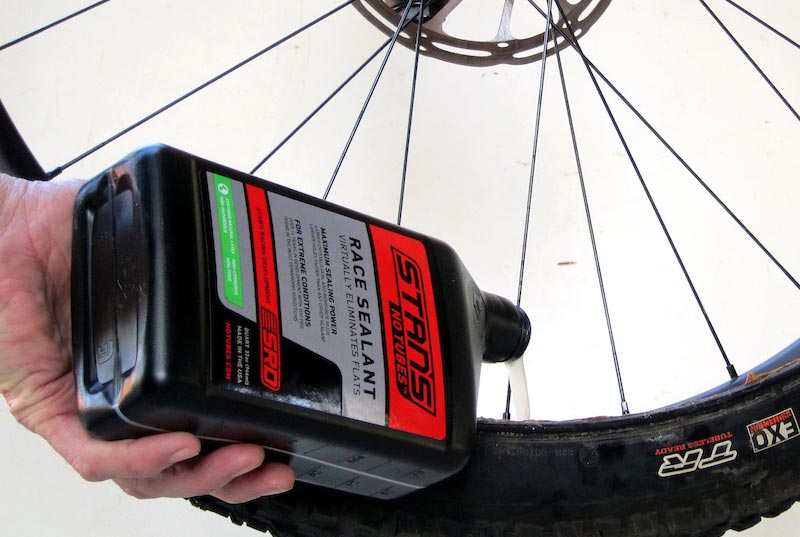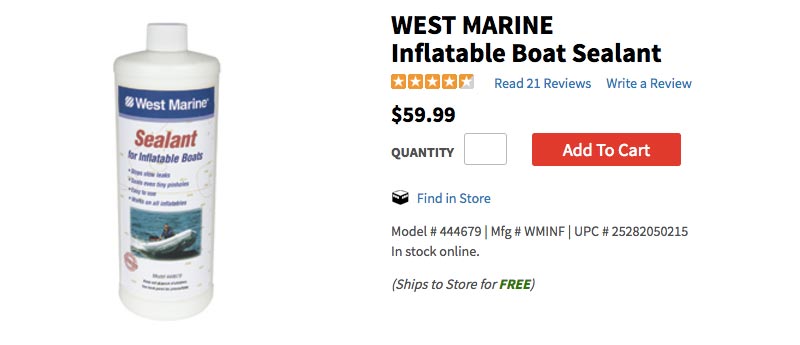If only our dinghy could repair itself

Bad news. Our inflatable dinghy has turned into a deflatable dinghy. Not overnight mind you, but gradually, over the past month or so, a super slow leak that required just a couple of pumps every few days to top up has now morphed into one that requires 10-20 pumps once or twice per day. Leaks like this are not uncommon, and are probably the biggest gripes for those of us who choose a RIB or soft bottom blow-up as a tender. If only there was an easy solution.

Adding Stan’s No Tubes sealant.
When we started researching for our new adventure, one of the things we learned is that many people who ride bikes are now doing so tubeless. Tubeless, you ask? How is that even possible? Apparently, the tires have a liquid sealant added inside them, which helps the tire seat itself onto the rim, allowing it to hold air when inflated. Not only that, the sealant can actually stop the air from escaping when the tire is punctured by a thorn, nail, etc., essentially making them self-repairing. Wouldn’t it be nice if our dingy could operate the same way?
How well does this sealant repair a leak? Check this out!
There are other benefits to running tubeless as well. Decreased weight (the sealant is lighter than tubes), and the ability to run lower tire pressures without obtaining a pinch flat, are among them. For all these reasons we have decided to have our new bikes set up tubeless.

Tumbleweed Prospector with tubeless-ready tires.
On the subject or repairing our dingy, it now looks like I’m going to have to tackle that job. I’ve repaired leaky RIBs successfully on a few occasions, but at other times, my results have been less than satisfactory. The text below, written by a very-helpful cruiser in Grenada who repairs inflatables as part of his job, explains some of the intricacies that make the task so difficult. Note that what he wrote was in response to someone asking for help on a leaky PVC dinghy, but the principles remain the same for a Hypalon one like ours.
The key to a successful and permanent repair relies on three critical factors. Firstly the adhesive must be two pack and mixed in the correct ratio. One pack is only for temporary repairs. Secondly comes surface preparation. Adhesive will not adhere to old adhesive or to a surface which is contaminated in any way. For PVC use MEK or Acetone to do a final clean and never Xylene or Toulene. This step is critical and is one of the differences between a successful outcome or a dismal failure. Thirdly is climate control. These adhesives are designed to be applied in a temperature range from 18 degrees Celsius to 24 degrees at most. Humidity must be below 60% and ideally around 45%. If you get this part wrong, the adhesive will ‘bloom’, that is begin to absorb moisture and you will notice a milky coloured sheen begin to appear. – Donal
UPDATE March 21, 2017
We received a comment on our Facebook page recommending this product from West Marine. The majority of reviews for it seem quite positive.



I have heard of people using expanding spray foam in their dingy, to get a few more years out of it before re-tubing.
I don’t know anyone who has actually invested the time or money to re-tube a dinghy. Everyone I know just buys a new one after passing their PITA deflatable off to someone else.
If someone had a $25-30k center-console RIB they would probably want to re-tube it when the original flotation tubes started to fail.
https://www.zar-formenti.net/cms/en/products/zar-43
Then again, anyone with a boat large enough to be able to carry a huge center-console like this would, probably could just afford to ditch the old one and buy a new one and not care about the money.
Not suggesting that it hasn’t been done. I’m sure it has, but it’s not common on the dinks that we see and use. Likewise, I’ve heard of the foam thing before too, but have never come across anyone who has done it either. That may, in fact, just be one of those internet folk tales. Anyone have a link where someone has done it?
I don’t think the foam thing would work very well. The expanding foams I have used are not exactly like the foams used in semi-structural use in boats or even the foamboard used in construction. Even when cured it tends to crush and contract under a load or force and will shrink quite a bit over time if any pressure is placed on it. I would think that in use it would start to crush up and the tubes would get loose, almost like they were losing air. Foam might be quite a bit heavier than air as well. Maybe someone could lay fiberglass over the tubes like they do to stitch and glue constructed dinghies. That would add even more weight though.
Or just patch it like normal, and then get rid of it when it is ready to be retired. 🙂
I’m with you, I don’t think it would work.
The WTB rims you are using are UST compatible. I would highly recommend using UST tires, they stay locked on the rims much better than some of the other types and require less sealant and monkeying around. This also allows you to run lower pressures for sand, etc. without worrying about rolling the tire off.
The pic in the post is not our bike. It’s one built up on one of the prototype frames.
Our bikes will have WTB rims though: Scraper i45s. The tires we’ll be starting off with are Maxxis Chronicles.
Yeah, I know. You told me what rims you were using in a previous comment reply. The Maxxis Chronicles aren’t UST but may be fine if they fit tight. The WTB tires seem to use UST more than some of the other brands. They run a little heavier but stay on better and the sidewalls are more durable.
Can you please give an example of the tire you’re suggesting, Javan?
I just found this link:
https://www.pinkbike.com/news/To-The-Point-UST-Rims-Tires-2013.html
Yeah, that article is great for explaining it. WTB Bridger is a UST tire that would fit your rims. I’m sure there are several variations that would fit with the same UST bead. One of my kids has the UST rims and tires and they have been bulletproof. No leaks, no rolling off the rim (like mine) and just no problems.
Thanks.
No problem. A tire similar to the Chronicle would be the WTB Trailblazer and it comes in a lightweight version and a tough casing version for durability. Lots of options.
Cool!
FYI, Mike, I used a product called toobseal on my inflatable. It did slow the leak down to an acceptable amount, BUT the goey stuff made the valves stick so adding air became a much more complex process since the valve wouldnt close properly once i pumped up the tube. ended up just buying a new inflatable.
That’s a pretty bad side effect!
Fpr leaky valves (the only leaks I have had) a few drops of glycerine each year renews the seals.
Maybe that’s our problem?
Actually, I do know where there is at least one leak.
My concern with sealants has always been that the old ones rendered the tube/dinghy/tire repairable if the sealant didn’t hold. I would want to do a little more research–it may be better to be able to repair the tire, which is easy, than have to have a tire you can’t fix. I’ve got to believe someday you will find your self trying to do a sidewall repair, and the goop may make that impossible.
But someone actually knows.
From what I have read and recall…
Holes that are too large to seal themselves can be plugged. More sealant can be added if a lot has escaped. Tires are then re-inflated and off you go.
A sidewall tear can be repaired the same way it would if you were running tubes. A patch or a boot can be sewn in, etc.
Running too low pressures can sometimes result in the seal being broken. The challenge is that reseating it MAY require more pressure than some small pumps can handle. For this reason some people carry CO2 canisters.
Additionally, people typically carry a tube for the “can’t re-seal” scenarios.
This is a good post on the subject:
http://www.bikepacking.com/plan/traveling-tubeless-guide/
Hello All.
So, looks like you’ve got the tubeless tire project well underway but what, if any, thoughts about using a health shot of Stan’s in the dingy and massaging it all around?
Thanks,
-Steve
Hi Steve. I think it would take a LOT of sealant to be effective. It sure would be nice it if would work though!